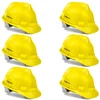GRAVITECH Strong Cap-R Helmet offers robust head protection with high-density polyethylene construction.
Features a four-point suspension and adjustable ratchet for a secure, comfortable fit.
Certified to IS 2925 and withstands electrical resistance up to 20kV.
Lightweight design ensures comfort during long work hours.
Ideal for construction, manufacturing, electrical, and industrial applications.



 Delivery By: Nov 23 - Nov 25
Delivery By: Nov 23 - Nov 25 









